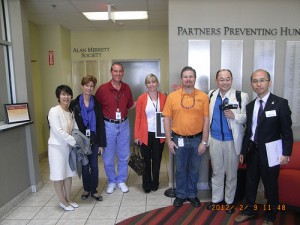By Yusuke Wada
Recently, I received a report about Food Bank Yamanashi’s visit to St. Mary’s Food Bank Alliance (SFMBA) in Phoenix, Arizona in February 2012. In the report, they listed all the things they learned in Arizona, and they also gave good insights about the future of food banking in Japan. The report is good for those interested in learning about food banks in the US.
We will post the translated report soon, but for now let me share some highlights I found interesting.
The difference in legal and tax systems:
The legal and tax systems in the US are very supportive of food banks. One thing they mentioned was the “Bill Emerson Good Samaritan Act” of 1996, which protects food donors from liability such as food poisoning. In Japan there is no specific law to protect donors.
The tax system in the US provides benefits to donors through tax deductions. The more food a donor gives to a food bank, the more tax deduction they can receive (up to twice the cost of the donation). While the original proposed 1998 NPO Law had a similar provision, it was taken out and replaced with the current system of nonprofits needing to make a special application for this status and the amount of tax deduction was dramatically reduced.
In general, Japanese social systems are highly dependent on the central government and the nonprofit sector is relatively small. This is one explanation why there aren’t many tax benefits for both financial donors and food donors. However, events like the 3.11 disasters have convinced more people for the need of a stronger nongovernmental/nonprofit sector in Japan. Many realized the government cannot take care of all of the problems in society by themselves.
We are interested in cases in other countries. What does your country look like? We would like to hear about it from you. Please write to us at info@secondharvestasia.org.
Volunteering is a part everyday life:
In the US, many companies send their employees to a food bank to volunteer. Schools send their students to a food bank as well. While we were at St. Mary’s, we saw many high school students volunteering. They often volunteer so that they can get good references or recommendation letters from the place they volunteered. But it also seemed it was not just those reasons alone but that volunteering is part of everyday life in America.
Food Bank Yamanashi points out in the report that people in Japan should create more mechanisms to allow people to volunteer. Again, volunteerism is not something strong in Japan. This is because Japan hasn’t had cultural background for volunteerism that you see in the US. But still we see the seeds of volunteerism growing especially among the younger generation in Japan. One suggestion by Food Bank Yamanashi was that making volunteering one of the major requirements for the college entrance test. Considering heavy focus on paper tests in Japan, it might not happen immediately, but I think this is an excellent idea.
“Can-struction” might be another example of a “mechanism” to make people feel like volunteering. Groups use donated cans to create a sculpture or work of art. For them it is a fun to both collect food and use their artistic talent. Architects and designers are often involved giving advice on how to design these structures. This is a fun and good team experience for students.
The cooperation with the public sector:
In the US, the government buys food from manufacturers and farmers to keep the commodity prices at a certain level. They then provide the food to food banks. Another example is that some food banks are contact points where their clients can apply for government services like food stamps. You can see strong ties between food banks and the public sector.
I think this is a big one. In order for food banking to grow, you need to get the public sector involved in various ways. In fact, Food Bank Yamanashi knows that well, and they are the top-notch food bank in Japan in terms of working with the public sector. In Yamanashi, the local government doesn’t buy food from local manufacturers or farmers for the food bank, but their welfare departments share the information about poor individuals with the food bank so that the food bank can provide food packages to individuals in need. This is groundbreaking in a country where the nonprofit sector is fairly small and the government’s trust of the sector is not very strong. Food Bank Yamanashi is leading the way.
We are interested in hearing about stories in your country. Please share your story here in the comment section or write to us at info@secondharvestasia.org.
Second Harvest Asia will develop the regional food bank network in Asia to share best practices and experiences with other food banks. We hold online meetings regularly with Asian food bank members. If you are interested in joining our regional network, please contact us at info@secondharvestasia.org.

